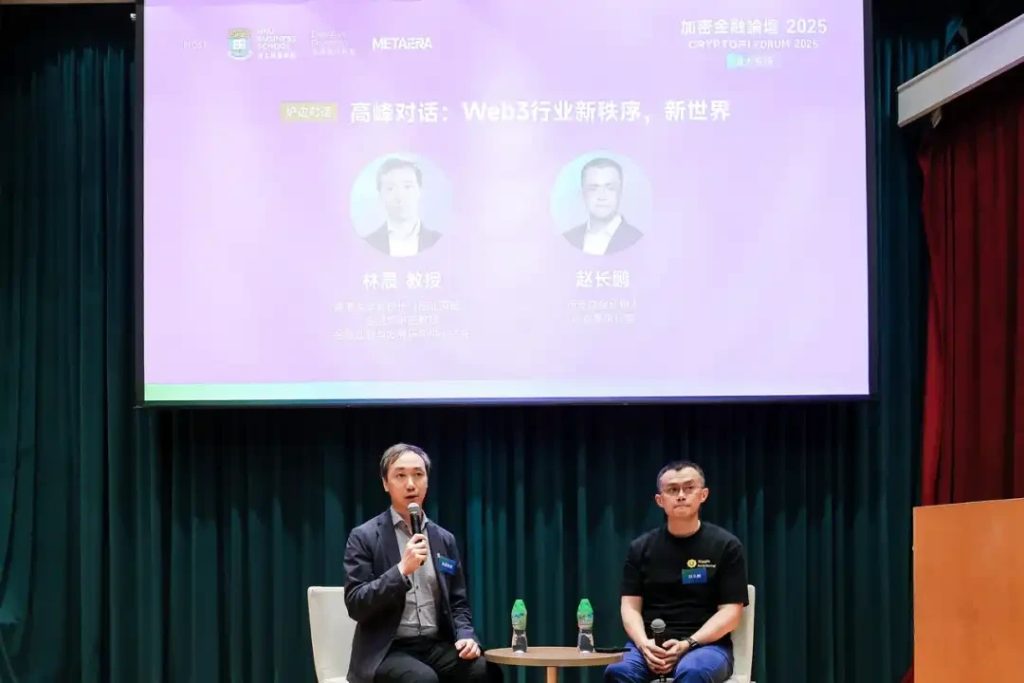
CZ’s Speech: Reshaping the Trading Landscape, DEX Will Surpass CEX in 10 Years
On August 27, 2025, Changpeng Zhao (CZ), founder of Binance, the world’s largest digital asset exchange, shared his forward-looking insights on the crypto industry at the “Hong Kong Crypto Finance Forum”. Here are the key takeaways, preserving his original tone.
Stablecoins: From “Safe Haven” to a Tool for USD Globalization
Though CZ joked he’s not a stablecoin expert, Binance handles ~70% of global stablecoin trading, making it a key distribution channel. He reviewed the evolution of stablecoins:
- Early Exploration: USDT launched in 2014 saw slow growth until 2017. Binance integrated USDT that year as a “safe haven” for users during market downturns (no complex agreements, just product integration) to improve UX, as Binance then lacked fiat trading.
- Boom Period: USDT grew with the rise of crypto-to-crypto exchanges (including Binance) and became an alternative for Asian users struggling to access USD accounts. Tether, profitable but low-key due to U.S. regulatory pressures, avoided public attention.
- Regulatory Experience: BUSD, launched with Paxos in 2019, reached $23B market cap by 2023 (growing faster than USDT/USDC) before U.S. government shutdown. All user funds were fully refunded, proving its compliance and security.
Stablecoin Business Model: After obtaining licenses, platforms issue tokens when users deposit funds and redeem for cash when users withdraw—low barrier, high liquidity, and a core profit driver in crypto finance.
National Strategy: The U.S. government now recognizes stablecoins’ value to the dollar’s global地位. Over $100B USDT buys U.S. Treasuries, with almost all users outside the U.S., expanding dollar influence. CZ noted, “Stablecoins are tools for底层货币 globalization”—only USD stablecoins are mature, leaving huge room for other currencies.
RWA: Three Challenges (Liquidity, Regulation, Mechanism)
Real-World Asset tokenization has promise but faces unexpected hurdles:
1. Liquidity Dilemma
Financial products (e.g., stocks) tokenize easily; non-financial assets (e.g., real estate) suffer from “low volatility → low tradability → thin order books → poor liquidity”. For Hong Kong real estate, even 1 token holder refusing to sell can block full asset trading, creating “on-chain钉子户”.
2. Regulatory Complexity
Financial products face classification issues (security/commodity). Multi-agency regulation in major countries complicates compliance—firms need futures, spot, crypto licenses, often stifling business.
3. Mechanism Flaws
U.S. stock tokenization products (e.g., xStocks) have disconnected token prices from real stock prices, with persistent arbitrage gaps indicating broken mechanisms.
Opportunity Window: Stablecoins (backed by U.S. Treasuries) prove RWA’s viability. With U.S. policy supporting crypto and Hong Kong’s pro-innovation stance, now is a golden age for RWA布局.
Exchange Evolution: Decentralization Will Outpace Centralization
1. Exchange Essence & Future Vision
All on-chain assets are Tokens, technically identical (issued on Ethereum/BNB/Solana, easy wallet/exchange support). The key difference is compliance. Future exchanges will unify global asset trading—from buildings to celebrity IP rights—maximizing liquidity and price discovery.
2. DEX Will Dominate
- Current State: DEX relies on token incentives, with higher fees than CEX. Web 2.0 users prefer CEX’s email-password login and customer support.
- Future: DEX will scale in 5-10 years and surpass CEX in 10-20 years. Drivers include regulatory tailwinds (light DeFi regulation in the U.S.), lower fees via tech progress, and growing user familiarity with wallets. CZ noted Binance invests in DEX projects (minority stakes) to support the ecosystem.
Digital Asset Treasury (DAT): A Bridge for Traditional Investors
DAT packages crypto as stocks, enabling traditional investors to participate. Key models:
– Passive Single-Asset Holding (e.g., Strategy holding Bitcoin): Low cost, stable strategy.
– Active Single-Asset Trading: Relies on managers’ market timing, with uncertain outcomes.
– Multi-Asset Portfolio Management: Requires complex allocation decisions, high complexity.
– Ecosystem Investment: Allocates funds to生态建设 (e.g., Ethereum生态), demanding top management.
CZ said Binance prefers the first model for lower legal risks and costs. DAT lets traditional institutions (corporate treasuries, state-owned enterprises) gain crypto exposure, tapping a market larger than crypto itself.
AI & Web 3.0:交易量 to Surge 1000x
AI cannot complete KYC, so its monetary system must use crypto/blockchain. Future individuals may have hundreds of AI agents handling video editing, translation, etc., spurring massive microtransactions (e.g., 0.1 yuan per article section read). Crypto trading volume could surge 1000x.
Current “AI+Web3” products are often “shallow” (frontends calling ChatGPT), lacking real utility. Top AI firms are exploring productive tools. With trillion-dollar AI computing power costs (OpenAI spends $6.5B/PB/year, planning 10-100x expansion), Web3 may offer new funding paths. CZ predicts AI as a public good—open, decentralized, with token holders sharing income.
Read More《CZ演讲全文:重塑交易格局,10年后DEX规模将超过CEX》
This content is AI-generated and does not constitute investment advice. Please exercise your own rational judgment.
- Startup Commentary”Building LLMs: The Knowledge Graph Foundation Every AI Project Needs”
- Startup Commentary”The 17th Year of Tmall Double 11 and the New Map Rewritten by AI”
- Startup Commentary”How to Prepare Your Data for Artificial Intelligence”
- Startup Commentary”Small and Medium-sized Banks: “Cutting the Tail” in Loan Assistance”
- Startup Commentary”The Six AI Giants on Stage: AGI Is No Longer a “Future” Thing”




